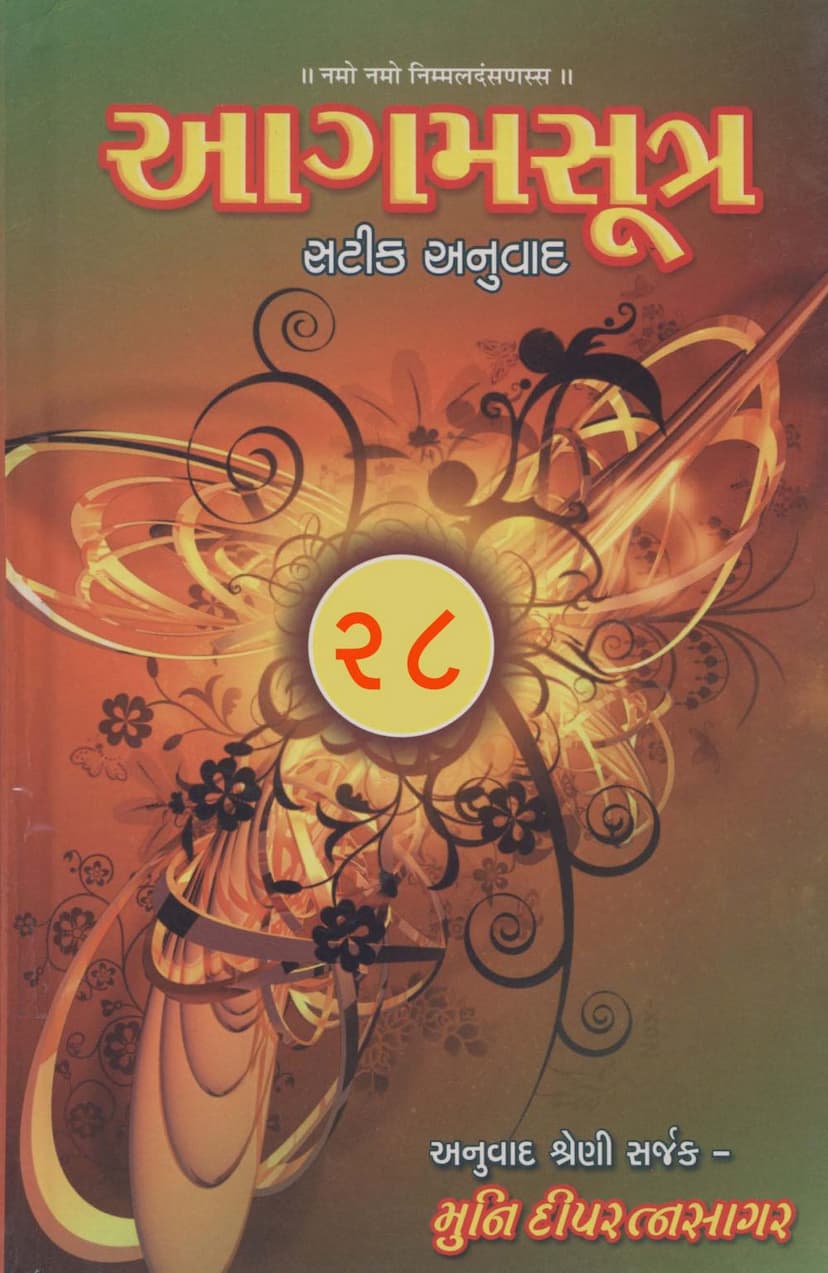Agam 23 Vrushnidasha Sutra Satik Gujarati Anuvad
Added to library: September 1, 2025
Loading image...

Summary
This document is a Gujarati translation and commentary of the Jain Agam Sutra, specifically Agam 23, Vrushnidasha Sutra, part of the Upanga Sutras.
Here's a breakdown of the key information presented across the pages:
- Title and Author: The book is titled "Agam 23 Vrushnidasha Sutra Satik Gujarati Anuvad" (Agam 23 Vrushnidasha Sutra with Commentary Gujarati Translation). The author and publisher are listed as Dipratnasagar (or Deepratnasagar).
- Translation Series: This is part of a larger series of "Agam Satik Anuvad" (Agam Sutras with Commentary Translation) created by Muni Deepratnasagar. The presented volume is specifically Bhag 28 (Part 28) of this series.
- Contents of Part 28: Part 28 includes the following texts:
- Nirayavalika
- Pushpika
- Chatuhsharan
- Mahapratyakhyan
- Tandul Vaicharika
- Gachhachara
- Devendrastava
- Vrushnidasha (This is the primary text focused on in the later pages)
- Kalpavamsika
- Pushpachulika
- Atur Pratyakhyan
- Bhaktaparigya
- Samstarak
- Ganividha
- Virastava
- Chandravidhyak These are described as five Upanga Sutras (8th to 12th in sequence) and ten plus one optional Payannasutras.
- Acknowledgments and Sponsors: Several pages are dedicated to acknowledging and listing the financial supporters and inspirers of this translation project. These include various Jain Sangh (communities) and trusts, demonstrating broad community support for the dissemination of these scriptures. Key figures mentioned as inspirers and patrons include Acharya Shri Harshchandrasurishwarji, Acharya Shri Devendrasagarsurishwarji, and Muni Shri Deepratnasagarji.
- Published Works by Muni Deepratnasagar: Pages 8-15 provide a comprehensive catalog of Muni Deepratnasagar's published works, which are extensive and cover various aspects of Jain literature:
- Original Agams (Mool): 49 publications of the original Agam Sutras.
- Gujarati Translation of Agams: 40 publications of the Gujarati translation of the Agams.
- Agam Sutras with Commentary (Satik): 46 publications of the Agam Sutras with detailed commentaries, totaling 13,000 pages divided into thirty parts.
- Agam Subject Index: A detailed index of subjects within the Agams.
- Agam Word Dictionary (Shabdakosh): A comprehensive dictionary of Agam words with references.
- Agam Name Dictionary (Namkosh): A dictionary of names and characters mentioned in the Agams with brief descriptions and references.
- Hindi Translation of Agams: 12 parts of the Hindi translation of the Agam Sutras.
- Agam Kathaanuyog: A compilation and translation of narratives and stories from the Agams.
- Agam Mahapujan Vidhi: A booklet on rituals for the worship of the Agams.
- Agam Sutra Satik Anuvad (Main Series): This refers to the extensive series of 42 volumes, covering 48 publications in total, which is the focus of this document.
- Other Literature: The catalog also lists works on Jain grammar, lectures (Vyakhyan), Tattva study (Tattvavada), Sadhana literature (Samadhimaran), rituals, worship, mystic diagrams (Yantra), devotional literature (Jain Bhakti), and miscellaneous publications.
- Content of Vrushnidasha Sutra (Pages 16-19):
- The Vrushnidasha Sutra is presented as an Upanga Sutra, the 12th in the fifth class of Agams.
- It is divided into 12 Adhyayanas (chapters).
- The translation begins with Sutras 1 and 2, which mention Lord Mahavir stating that he has spoken 12 Adhyayanas in the Vrushnidasha Sutra.
- Sutra 3 provides a detailed narrative. It describes:
- The city of Dwaravati, its splendor, and its location.
- The Revatak mountain near Dwaravati.
- The Nandanvan garden and the Surapriya Yaksha's shrine.
- The king Krishna Vasudev and his vast retinue of family members, princes, queens, and courtesans ruling Dwaravati.
- Baldev, another powerful ruler, and his queen Revati.
- Revati's dream of a lion, foreshadowing the birth of a powerful son.
- The arrival of Lord Arishtanemi (a Tirthankara) and the preparations made by Krishna Vasudev to welcome him.
- The narrative then shifts to the story of Nishadha Kumar, who hears the dharma from Varadatta Anagar (a disciple of Arishtanemi) and eventually becomes a Jain ascetic. His life, practices, and eventual rebirth in Brahmaloka are described.
- The text details how Nishadha, after his celestial lifespan, is reborn as a son to Revati in Dwaravati, thus explaining her dream.
- The story of Virangad, another character, is also recounted, highlighting his virtuous conduct and eventual attainment of liberation.
- The translation emphasizes that the remaining 11 Adhyayanas (Sutras 4 onwards) are to be understood according to the Sangrahani (compilation/classification).
- The text concludes with a brief explanation of some terms like "Viraf" (ancient), "Mayukshaya" (perishing of the lifespan), and "Avakshaya" (karmic dissolution).
- Finally, it states that the 12 Adhyayanas of the Vrushnidasha Sutra, with Muni Deepratnasagar's commentary, are now complete.
In essence, the document is a scholarly effort to make the ancient Jain scripture, Vrushnidasha Sutra, accessible to Gujarati-speaking readers through a detailed translation and commentary, supported by a wide network of patrons. The Vrushnidasha Sutra itself appears to contain mythological narratives and ethical teachings, tracing the lineages and spiritual journeys of various characters, including the famous Vasudev and Baldev, and the Tirthankara Arishtanemi.